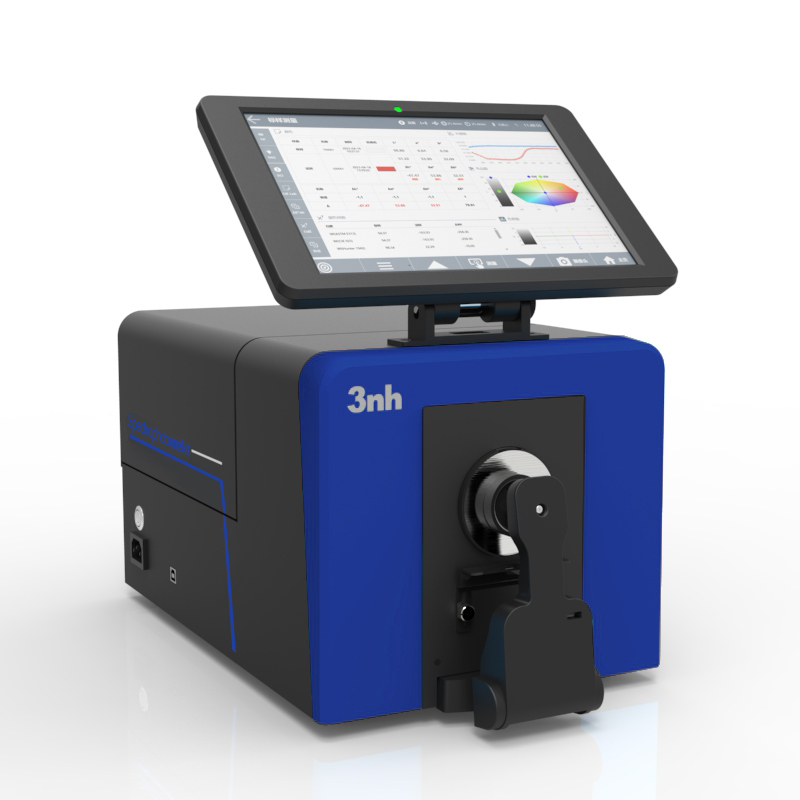Sunscreen color has a direct impact on its sun protection effect. Sunscreens with darker colors usually contain higher levels of UV absorbers, thus providing better sun protection. A spectrophotometer can be used to accurately measure the color of sunscreen and determine the content of its UV absorbers. This ensures that the sunscreen has sufficient sun protection effect while also guaranteeing its safety for the skin.
Sunscreen Color Detection Methods
Sunscreen color detection can be performed using a spectrophotometer or a colorimeter. The method is as follows:
- Set up the spectrophotometer or colorimeter: Adjust the instrument to the mode specifically designed for sunscreen measurement, which can usually be found in the device’s options or menu.
- Calibrate the instrument: Follow the instrument’s instruction manual to calibrate it first, ensuring accuracy in color measurement.
- Prepare the sample: In accordance with the method specified in the instruction manual, place the sunscreen sample into the sample container of the instrument’s tester. Try to press it flat against the back of the container to ensure it is stable.
- Conduct the test: Place the sample container into the instrument’s test chamber and start the test program. After the test is completed, record the results in a data sheet or record form.
- Analyze the results: Analyze the test results based on the selected parameters of the device and the test. The relationship between the sample’s color and the content of sunscreens can be obtained by comparing it with the measurement data of other samples or previous test data.
Note: To obtain reliable measurement results, use the measuring instrument correctly and follow the instruction manual for operation.
Principle of Sunscreen Color Detection
The principle of sunscreen color detection is based on optical measurement. The detection of sunscreen color is achieved by measuring the light reflected or transmitted through the sample and comparing it with the light from a standard sample.
For example, a spectrophotometer measures the absorbance or transmittance of the sample at different wavelengths of light. Then, based on the data at different wavelengths, it calculates specific color parameters, including hue, lightness, and color difference value.
A colorimeter, on the other hand, measures the three basic color values (red, green, blue) of the light reflected by the sample and compares them with the three basic color values of the standard white reflected light. Thus, it calculates the difference between the sample and the standard sample, which is the color difference value.
By using these instruments to measure and analyze the color of the sample, the specific color parameters of the sunscreen can be determined. The difference between these parameters and the specified standard color values can be compared to evaluate the quality and consistency of the sample.
Application of Desktop Spectrophotometer TS8560 in Sunscreen
Although testing sunscreen sounds simple, it is actually challenging. Sunscreen consists of water-in-oil or oil-in-water emulsions, and the mixing of these two substances with different properties is relatively complex. A colorimeter is used to detect the color of the mixed sunscreen and determine the mixing ratio and effect. The addition of powder components increases the difficulty of mixing, as they are not easily dissolved completely and may adhere to the sides of the mixing barrel as residues. These issues are likely to cause color inaccuracies. Without careful detection and strict quality control using a colorimeter, sunscreen manufacturers may bottle and ship products with incorrect colors. The products that reach consumers will be substandard, leading to problems such as an unnatural white cast on the skin and difficulty in spreading.
Caipu’s desktop spectrophotometer CS-821N series is also an excellent choice for sunscreen testing. It is equipped with two types of illumination light sources: pulsed xenon lamps and LEDs, along with a high-stability UV light source, ensuring stable fluorescence measurement performance. It supports over 40 color measurement indicators and can simulate and calculate color measurement data under multiple light sources and measurement indicators. As a high-stability desktop spectrophotometer, it enables accurate detection of product colors and plays a role in strict quality control.
Features of TS8560

- High-precision measurement: Equipped with a dual-array CMOS image sensor, it has high sensitivity and a wide spectral response range. The repeatability of reflected chromaticity values (ΔEab) is ≤ 0.01, and the inter-instrument difference (ΔEab) is controlled within 0.1, enabling high-precision and repeatable measurements.
- Multiple measurement functions: Supports more than 40 measurement indicators and 41 types of light sources (some implemented via upper computer software), which can meet special measurement requirements under different measurement conditions. It is equipped with four measurement apertures (Φ25.4/15/8/4mm), and the aperture and lens position can be configured according to needs.
- Convenient and fast operation: Configured with a 10.5-inch independent rotatable tablet computer, it offers fast response speed and comfortable operation. It has a built-in camera for view finding and positioning. Real-time view finding through the camera allows accurate judgment of whether the measured part of the object is the target center, improving measurement efficiency and accuracy.
- Wide sample adaptability: It supports multi-attitude placement and measurement, such as side measurement, upward measurement, and downward measurement (with accessories). The open transmission chamber makes it suitable for more measured samples. It also has an automatic temperature and humidity compensation function, ensuring more accurate measurement data.
Application in Sunscreen Color Detection
- Accurate color measurement: The TS8560 can accurately measure the color of sunscreen. By measuring the light reflected or transmitted through the sample, it calculates specific color parameters (including hue, lightness, and color difference value) based on data at different wavelengths, thereby accurately determining whether the sunscreen color meets the standards.
- Determination of UV absorber content: Since sunscreen color is related to the content of UV absorbers, sunscreens with darker colors usually contain higher levels of UV absorbers. By measuring the color of the sunscreen with the TS8560 and comparing and analyzing the data with standard samples of known UV absorber content, the content of UV absorbers can be determined, ensuring the sunscreen has sufficient sun protection effect.
- Quality control: During the sunscreen production process, the TS8560 can be used to monitor the color stability and consistency of the product. By regularly measuring sunscreen samples on the production line, color deviations can be detected in a timely manner, facilitating the adjustment of production processes, ensuring the stability of product quality, and preventing substandard products with color errors from entering the market.
- Data management and analysis: The TS8560 is matched with the SQCX quality management software. Measurement data can be stored in the built-in memory card, or transmitted to a computer or mobile device via USB interface or Bluetooth technology, facilitating data management and analysis. Through the analysis of a large amount of measurement data, the changing trend of sunscreen color can be understood, providing a basis for product research and development and quality improvement.

